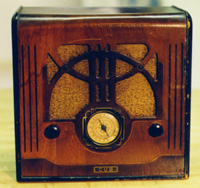| About Joe's Radio Page |  |
|||
| Thanks
for stopping by my site! Creating a web site is
only worthwhile when people come to visit! Joe's Radio Page first came on the air in 1996 as a showcase for my growing collection of radios. In 1997, I reworked it with new photos, links, and descriptions, and in 2002 I undertook a project to re-do the site again, updating the descriptions, streamlining the layout, and adding new items. In 2004, I relocated this site to a new server and web address, and finally in 2011 I went through the site and updated some descriptions and images. I know this site has a very "Web 1.0" feel to it, and that's completely intentional. Over the years I've thought about building a whole new site and jazzing it up a bit, but I like the simplicity of the current setup. And I figure if I keep it around long enough it'll be "retro." :) This site has had hundreds of thousands of visitors since the "go live" date. Many readers have written to tell me about the radios in their collections, and I have to admit I'm a little envious of some of you. Some of you have written asking what I think the value of your radio(s) would be; see below for my tips on pricing your radio. My interest in radio started when I was about 10 years old, when my mother showed me a trick her father showed her: tune your (AM) radio to a very quiet spot on the dial, and turn it up to see where the station is from. I remember being amazed, sitting at my parent's kitchen table with a Panasonic transistor table radio, logging stations all the way from Boston and Fort Worth from my kitchen in the suburbs of Chicago. From there, my interests went into shortwave (I used a Hanimex multi-band unit), then CB. (Here's a photo of my listening post/bedroom in 1975.) Then came high school, college, the Real World, and my radio hobby took a backburner. Years later, I picked up the hobby again when I found this radio in the DAK catalog. Within a couple years, I was back at the hobby full-force. After many garage sales, estate sales, phone calls from friends saying "Hey, I heard from this guy...", and seeking out cool stuff in catalogs and in stores, my collection grew to include most of the pieces you see on this site. As time went on, I decided to part with some of my radios. That's why in some cases you will see descriptions that include where the units are now. A very good friend of mine has always said that equipment like this "should be used and not left to sit on a shelf somewhere," so here's to the new owners of these radios and the wish that they are getting a lot of use out of them. Finally, the single question I am asked more than any other is: "My mother/grandfather/aunt/great uncle/cousin left me a Grundig xxxx radio. Can you tell me what it's worth?" This is a tough question to answer. Like any collectible, a radio is worth what a buyer is willing to pay. And with sites like eBay bringing so many of these radios to the market, buyers are getting more selective about what they buy and how much they will pay. The best advice I can offer is for you to go to eBay's "Search" page, and look for your radio under "completed items." This will give you a clear idea as to what the market looks like. If your specific model is not listed, take a look at the descriptions and pictures to see if something comes close. Obviously, the condition of your radio has a lot to do with its value, too. If it works well and the cabinet is in flawless condition, congratulations! If it is not is top shape, then the value will diminish rapidly to the potential buyer. Good luck and thanks again for stopping by! --Joe Lynn, jt_lynn@yahoo.com Updated 8 July 2011 |
||||